Part 4: Shigatse and Gyantse Stupa to Kathmandu
Whilst we were there, Mark sent us an email informing us of the recent Nangpa-La pass shootings. Chinese soldiers had opened fire on a group of ~70 Tibetans trying to flee the country to seek asylum in Nepal, killing two of them. The whole episode was witnessed and filmed by a large western climing team at Cho Oyu. When released to the global media, the Chinese Govt. offered up some guff about how they were attacked by the Tibetans, firing only in self-defense and then one person died of altitude sickness afterwards (!). Surely they could have made up a more believable story than that? [note: more than half of the group managed to get to the refugee reception centre here in Kathmandu. They left for India about a week ago. The fate of the remainder is still unknown].
This was a stark reminder. Not only of the paltry nature of my own challenges there, but also of the seriously aggressive nature of the current communist regime and their ongoing violent treatment of Tibetans.
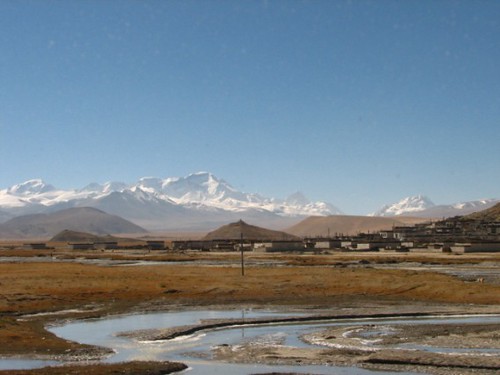 Nangpa-la pass (gap in the mountains on right). Site of recent shooting and killing of Tibetans whilst fleeing Tibet to seek exile in Nepal.
Nangpa-la pass (gap in the mountains on right). Site of recent shooting and killing of Tibetans whilst fleeing Tibet to seek exile in Nepal.
Shigatse was the first place were i have seen Tibetan beggars; lots of them. The town is large by TAR standards with a sprawling CBD grid and a very clear division between the old Tibetan quarter and the new Han Chinese side of town. Tashilhunpo Monastary, once home to the Panchen Lama (no. 2 in the Tibetan theocratic hierarchy) is nestled in the foot of a large hill on one side of town. A must see for Tibetoids.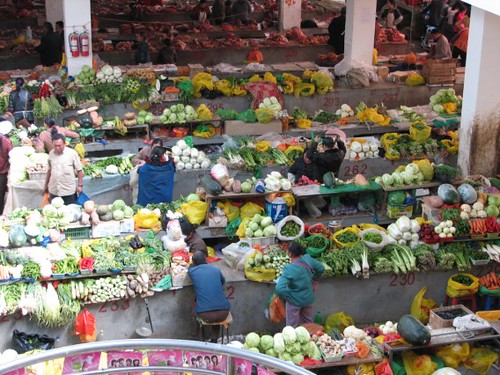 Veg market in Shigatse
Veg market in Shigatse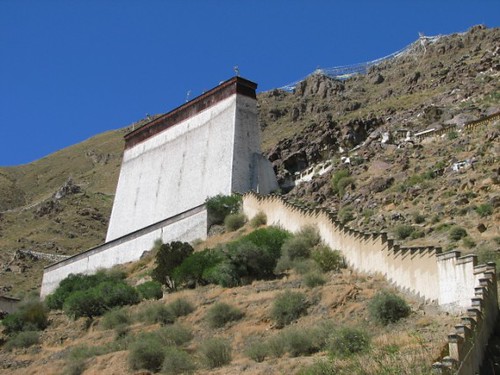 Part of Tashilhunpo Monastary
Part of Tashilhunpo Monastary
So we paid the ticket fee and entered the gates. Amazing architecture intact, as due to connections between the Panchen Lama and China the monastery was largely spared the ravages of the cultural-revolution that saw the vast majority of Tibet’s monasteries reduced to rubble.
Tashilhunpo monastery, once home to about 4000 monks, now home to several hundred. My first impression was how weirdly quiet it was. According to the Chinese jinglish sign near the ticket gate, it was a functioning Tibetan monastery; which are normally throbbing with noise and activity; normally resonating to the sounds of debate and recitation, the deep boom and thunderous banging and trumpeting of pujas?? This place was a freaky, silent ghost - a dead-heart reminder of what was.
Empty debate courtyards flanked by little arrows and yellow lines to herd the tourists in the appropriate direction. Not a functioning monastery at all. Welcome to "Disney-land" Tibet. Plenty of rides for the willing! Stunning camera opportunities in side-show Gompas for those willing to pay the camera fee! Roll up and roll on,.....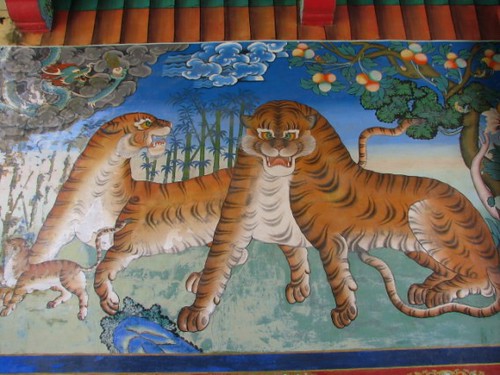 Entrance gateway art at Tashilhunpo
Entrance gateway art at Tashilhunpo
There were many Tibetan pilgrims also, still keen to pay their respects to the Panchen Lama and prostrate before the huge and otherworldly Maitreya statue. Their devotion and energy was genuine and a relief to witness.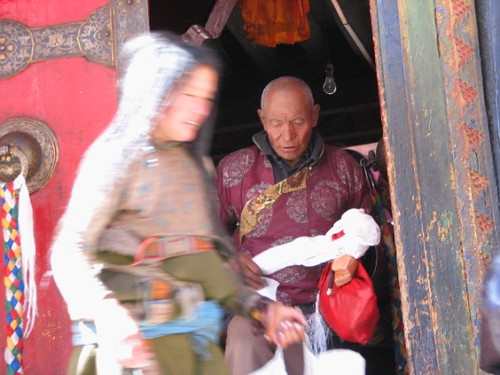 Pilgrims at Tashilunpo Monastary
Pilgrims at Tashilunpo Monastary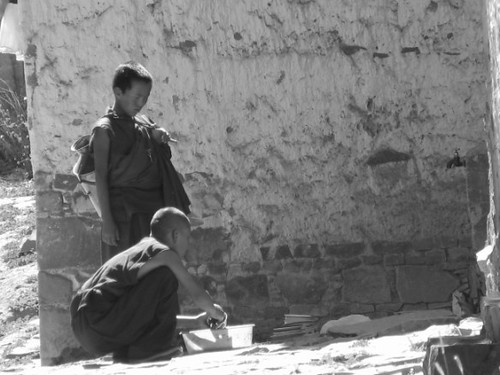 Young Monks washing
Young Monks washing
Monks had been turned into side-show ticket collectors for the Chinese. Bored and fidgeting with mobile phones, gathering camera fees from groups of tourists in each separate temple. Cobblestones once worn smooth with ~500 yrs of trampling monk feet - now mostly squeaking with the nikes and trainers of Western tour groups and wealthy Chinese.
Eavesdropping on the offal being dished up by Chinese/Tibetan guides to unsuspecting tour groups of Westerners and Chinese - paying oodles for their privilege and lapping it up with nodding heads; not a clue about the other version of history. I felt like screaming out, "This is bullshit!". Too much for this heart to bear with equanimity.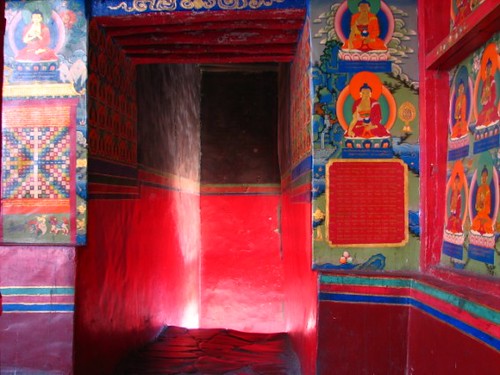 Buddhas in red light
Buddhas in red light
As you can guess, i was not impressed. As we wandered through the complex, past so many locked doors, i found myself feeling nauseated, both by what i was seeing, sensing and the interpretations i was adding to it. We stumbled into some of the accommodation buildings and went looking for the monks and saw mostly empty rooms, rancid with rat piss, piled with rubbish. Rock-on religious freedom in Tibet,......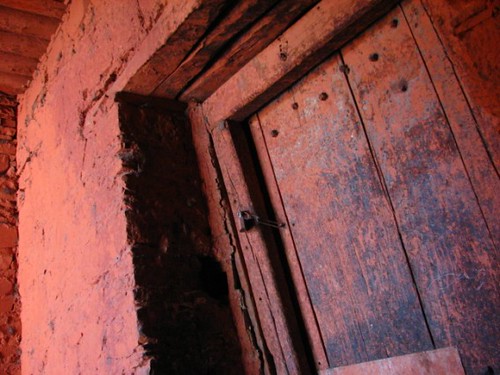 Locked doors and empty rooms,.....
Locked doors and empty rooms,.....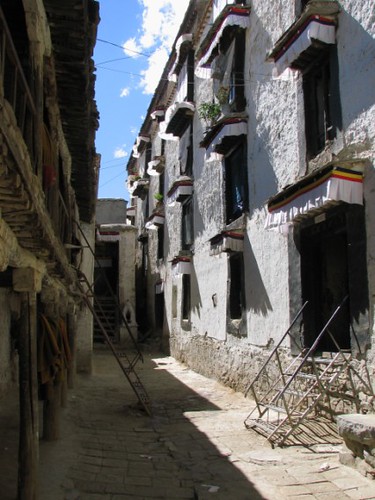 Living quarters that were actually lived in at Tashilunpo Monastary
Living quarters that were actually lived in at Tashilunpo Monastary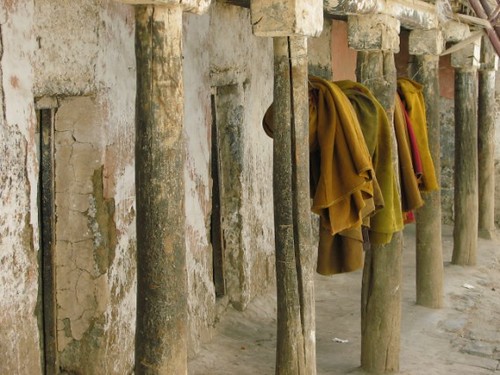 Robes waiting
Robes waiting
The Panchen Lama is being bigged up by the Chinese, keen to spout about the closeness of their ties to Tibet and historical links with him. Pictures of the Chinese chosen reincarnation adorn all the temples - no sign of the other boy who went missing over ten years ago now and whose whereabouts have not been independently verified since. The Panchen Lama traditionally played a pivotal role in the search and selection of the new Dalai Lama and thus has immense potential political value for the Chinese Government. What a life - as a pawn in a massive power play.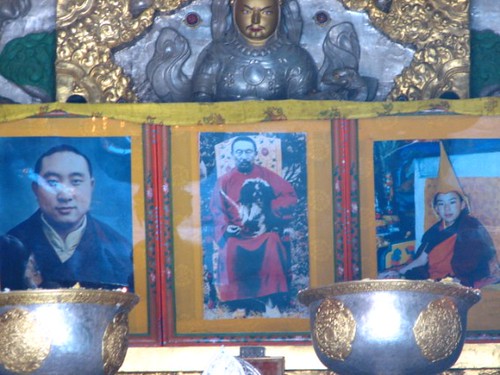 Previous Panchen Lama and the Chinese chosen 're-incarnation' adorning the temples at Tashilhunpo
Previous Panchen Lama and the Chinese chosen 're-incarnation' adorning the temples at Tashilhunpo
On the way out we decided to pay a visit to a special museum dedicated to the Panchen Lama, mostly out of interest to see what the official blurbs say. We were the only two in there and had our own little spy monk trailing behind us the whole way, who gave away his English capacity accidentally at the end.
The museum was - to be expected i guess - full of communist party drivel; a narrative that was partly fictional and that conveniently left gaping holes in its very one sided depiction of recent history. One stunning visual example of the central Governments arrogance and lack of understanding was plastered all over the walls of the museum - traditional paintings of Tibetan saints and deities, alongside contemporary depictions of communist party leaders making speeches and shaking hands with the Panchen Lama, past and present. No idea of irony.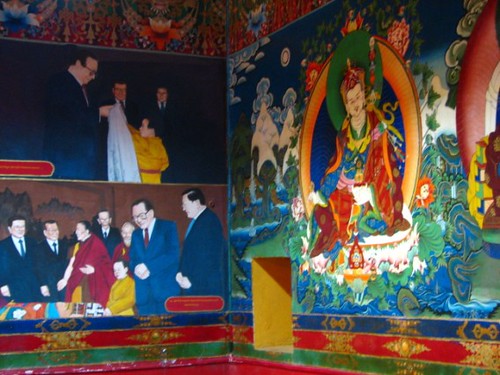 No idea of the irony? Murals of a Chinese president meeting with young Chinese chosen Panchen Lama, alongside deities, saints and sages
No idea of the irony? Murals of a Chinese president meeting with young Chinese chosen Panchen Lama, alongside deities, saints and sages
I am aware that the tone of this is becoming more negative and sarcastic, a more or less accurate reflection of the direction my mind was heading at the time. Writing thoughts and feelings retrospectively is interesting. I have softened and opened a lot since leaving the TAR, having had space to process and integrate the experiences. But at the time i was seeing red!
Communication breakdowns were commonplace in the TAR and one of the few sources of amusement in Shigatse. One time Anna wanted to acquire some plastic chopsticks in order to stop using the wooden disposable ones that you are given in most restaurants. In a supermarket, she went in armed with a couple of wooden ones to mime her request (miming can get you a long way!). After miming she broke the wooden chopsticks in half and pointed to some plastic object. They nodded in comprehension - wandering off to return with some glue - to repair the broken chopsticks of course!
Some 'communication breakdowns' were not so amusing. At an internet cafe in Shigatse a young woman repeatedly tried to overcharge us. On the third occasion, when we owed 4 yuan, she tried to hit us up for 12. I pointed at her computer screen explaining that the two terminals we had been sitting at both displayed 2 yuan each - clearly, obviously and she knew it. She had a full hissy fit and mouthed off some Chinese obscenities at us as we paid her appropriately, as if we had ripped her off??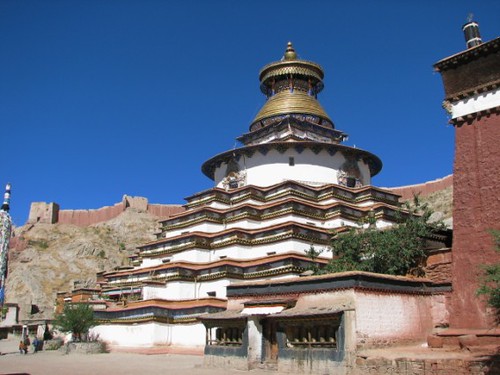 Gyantse stupa
Gyantse stupa
Around this time we decided against going to Lhasa. Didn't have the heart. However, there was one more place we wanted to see - the Gyantse stupa, about 70 km east of Shigatse. This is one of the largest stupas in Tibet and has some of the best preserved statues and wall paintings in the TAR, surviving the cultural-revolution due to links with Tashilhunpo and the Panchen Lama.
After more bullshit, lies and difficulties with transport wallahs, we got on some public transport to Gyantse. A surreal experience sitting in a crammed mini-bus, smooth-as-glass tar road, doof-doof on the inside, while scenes of rural Tibet slid by on the outside; the barley harvest being threshed and winnowed; large piles of grain sitting in the sun; trees turning autumn yellow and massive piles of hay and barley stalks on hopelessly overloaded carts and tractors.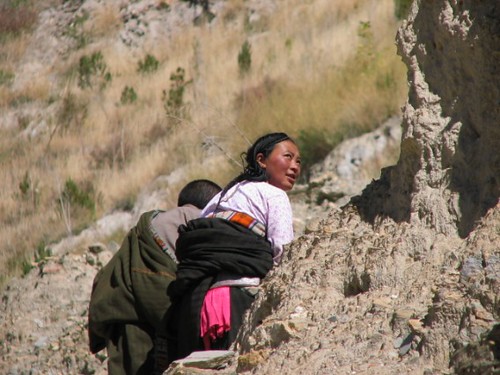 Young Tibetan woman looking towards Gyantse stupa with devotion
Young Tibetan woman looking towards Gyantse stupa with devotion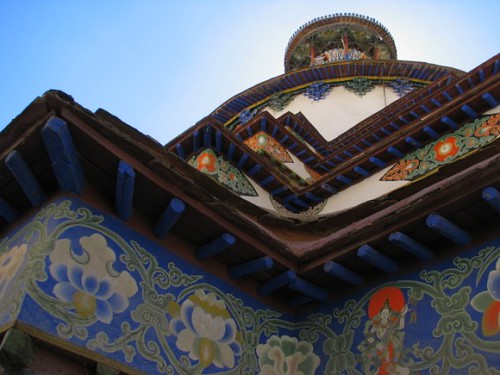 Gyantse stupa view
Gyantse stupa view
Again paying money to the ticket collector monks - attending to the sideshow rides in Theme park Tibet with listless enthusiasm. The Stupa itself was truly astounding, so well preserved and much more alive than Tashilhunpo - it is incredible that it wasn't trashed.
We spent several hours checking out the temples and gradually winding our way up the levels, past depictions of all manner of peaceful and wrathful deities. The symbolism gets gradually more complex and Tantric related as you ascend. A feast for Tibetan Buddhist dharma buffs. I will spare you the commentary and leave the photos to speak for themselves.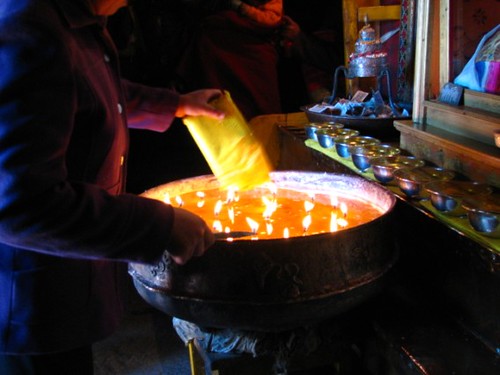 Woman making light offerings at the Gyantse stupa
Woman making light offerings at the Gyantse stupa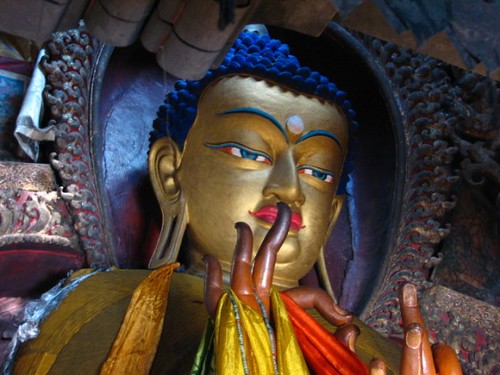 The Buddha (not picking his nose, just a bad camera angle!)
The Buddha (not picking his nose, just a bad camera angle!)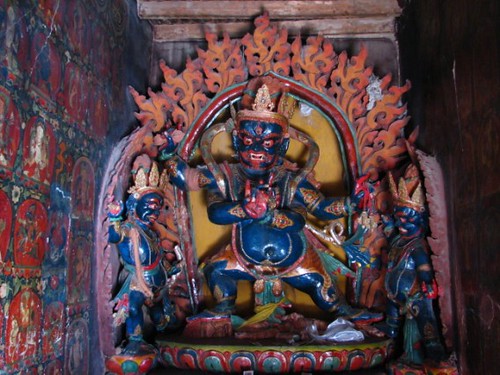 Wrathful deity doing the wrath-stomp on the ego
Wrathful deity doing the wrath-stomp on the ego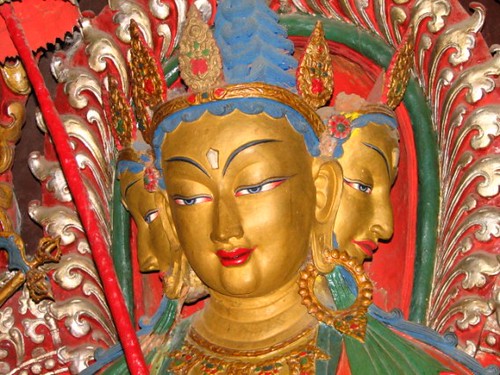 Multi-faced Tara
Multi-faced Tara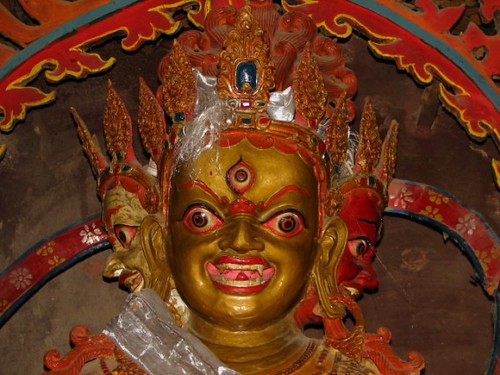 Wrathful deity
Wrathful deity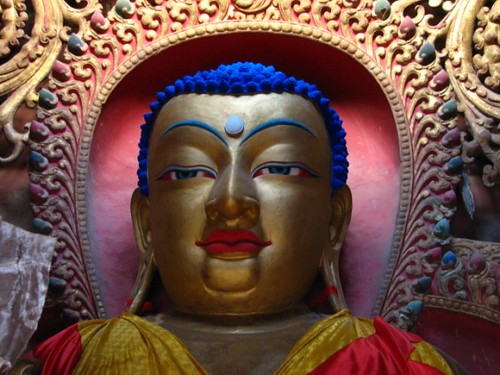 Maitreya statue close up
Maitreya statue close up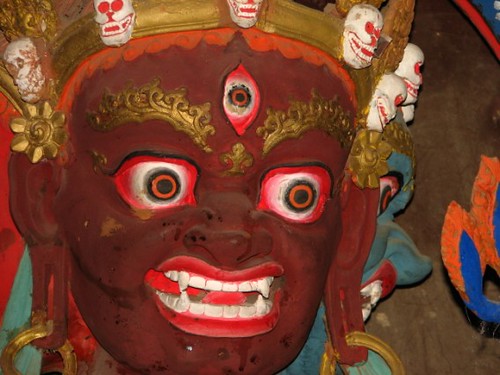 Another wrathful deity - a good pictorial representation of how i was beginning to feel towards the Chinese by this time!
Another wrathful deity - a good pictorial representation of how i was beginning to feel towards the Chinese by this time!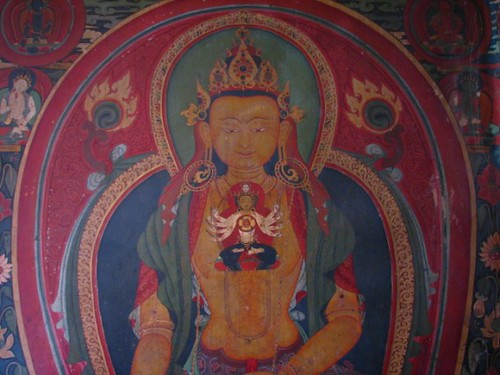 Guru at the heart, in the heart of the guru's guru,.....
Guru at the heart, in the heart of the guru's guru,.....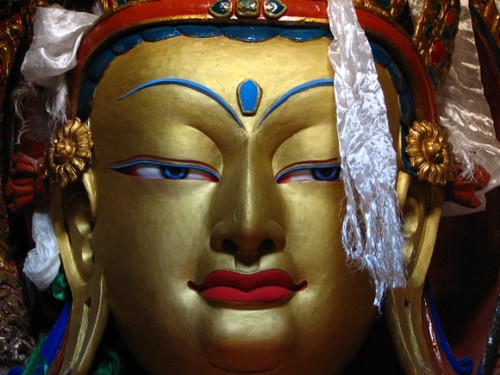 A very serene looking buddha statue
A very serene looking buddha statue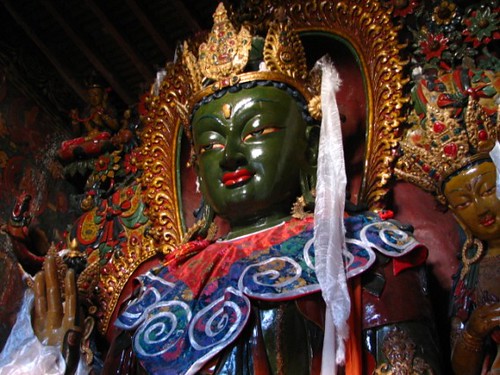 A Green Tara
A Green Tara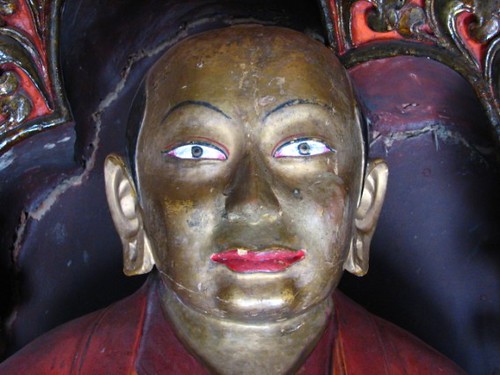 One of many, rather intense looking, Buddhist masters long past
One of many, rather intense looking, Buddhist masters long past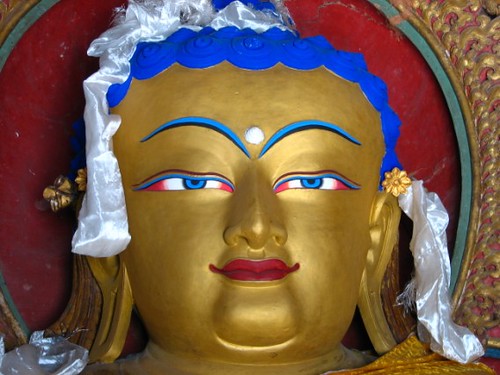 Another very serene Buddha
Another very serene Buddha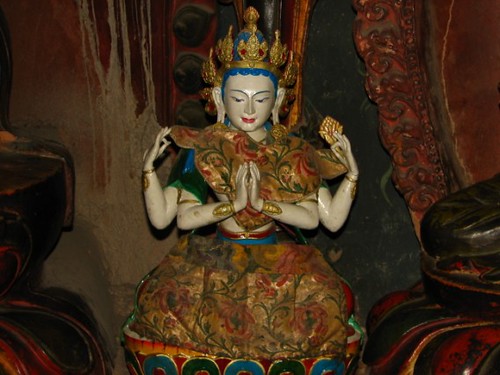 A four armed White Tara
A four armed White Tara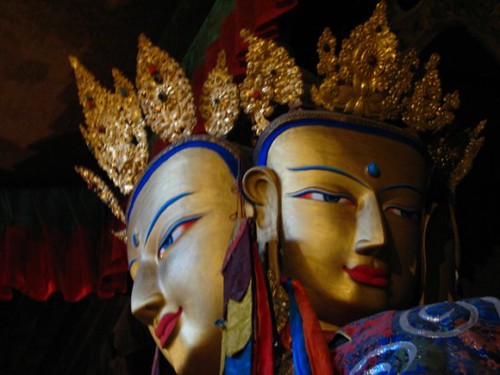 A four faced Chenrezig (?) or Amitabha (?) or maybe Vajradhara, not sure,....
A four faced Chenrezig (?) or Amitabha (?) or maybe Vajradhara, not sure,....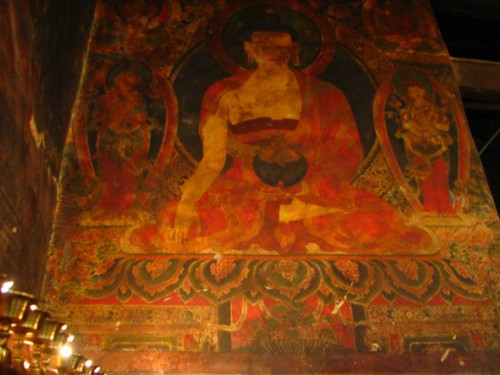 The main man, in the earth touching mudra
The main man, in the earth touching mudra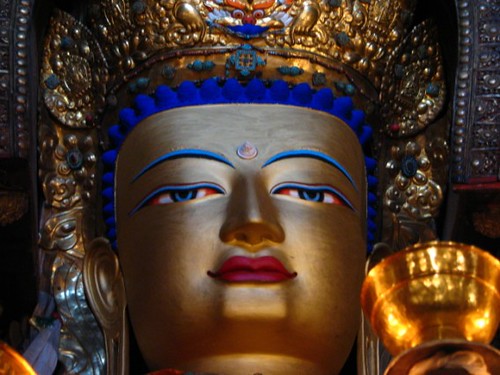 Definitely Vajradhara, i think (?)
Definitely Vajradhara, i think (?)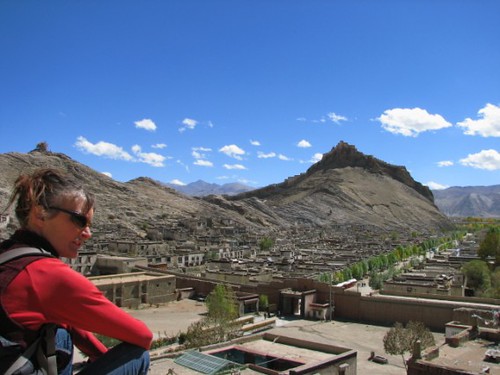 Views over the Tibetan quarter of Gyantse from the top of the stupa
Views over the Tibetan quarter of Gyantse from the top of the stupa
The main gompa at Gyantse, complete with its chanting monks was strange. I couldn't tell if it was authentic or another revenue generating tourist side-show, replete as it was with frame-snapping tourists filing in and out, circambulating the fringes with flashes firing in a feeding frenzy for the friends back home. After the Stupa statue fest, we decided to check out the old Dzong on the hill. Historically significant and towering over the town it seemed well worth a look.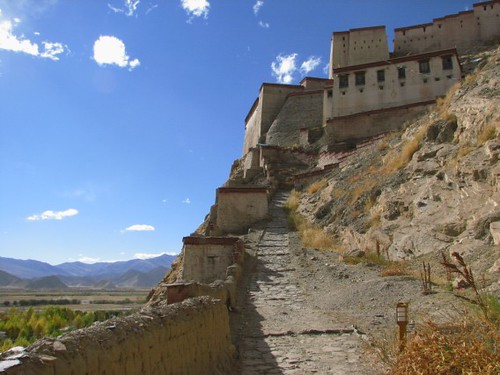 Gyantse Dzong (fort), dominates the hill with commanding views of the entire valley
Gyantse Dzong (fort), dominates the hill with commanding views of the entire valley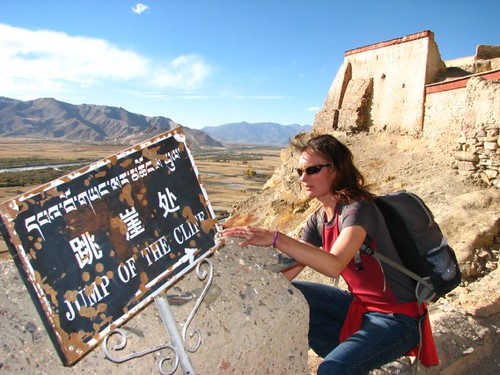 No Anna, don't do it, don't do it! The foods crap, sure, but not that bad!
No Anna, don't do it, don't do it! The foods crap, sure, but not that bad!
Again, the signage at the Dzong presenting the official Chinese version of history was so warped as to resemble a novel. In frustration i asked the money collecting lady (not a monk this time) whether the money we were forking over stayed in Gyantse or went to Beijing. She looked shocked and did not answer imediately, but as i was walking off replied in Tibetan "To Beijing".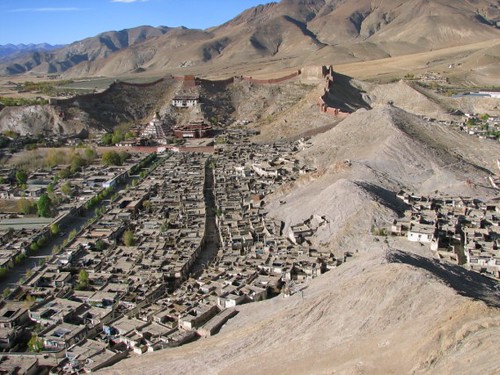 View from the fort towards Gyantse stupa and main gompa compound
View from the fort towards Gyantse stupa and main gompa compound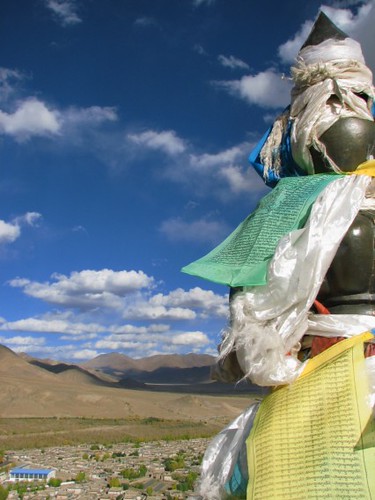 Prayers on the hill. Tibet needs them,.....
Prayers on the hill. Tibet needs them,.....
When i reflect back now, at around this point i fully lost it. Back in Shigatse i found myself spontaneously bursting into random obscenities abut Chinese - stuff that is not worth repeating. I vividly recall Anna breaking into tears one day in our hotel room in Shigatse and saying "I'm sick of being related to like i'm not a human being". Ditto. That was half the reason for deciding to bail from the TAR - ASAP.
The other half was my inability to handle what i was seeing, and of course the interpretations my mind was adding to it, with any semblance of equanimity. Part of me felt like leaving a big turd on the main road at the border and planting a flag in it saying "Fuck China!". Crass, horribly immature and rather sad - but true.
So, given such an imbalanced inner response at the time it was definitely best to leave. For the sake of all sentient beings! Really, in a deep sense there is no such thing as "China" or "Chinese" to blame and get mad at - just a collection of individual humans, each with their own unique stories, personal histories and shared cultural heritage. To be fair we also had plenty of interactions with lovely Chinese people - mostly women when i think about it (?) - in shops and in restaraunts whilst doing food order miming routines.
When one considers, it is obviously impossible to treat other people like shit, bark like a dog at them and behave in such insensitive fashion and also be a happy human being. Reflecting a little on the individual and collective trauma of the Chinese in the last 60 yrs, their behaviour suddenly becomes very explainable - not necessarily excusable, but highly explainable! What they experienced as a nation under Mao and during the cultural-revolution is well into the outer-orbits of insane human relations and almost impossible for us Westerners to imagine.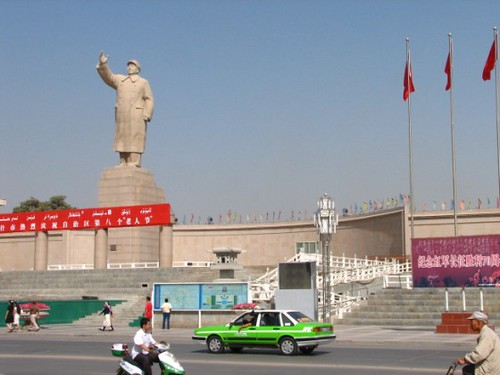 Monument to a meglomaniac in Kashgar. Recent estimates put the number of deaths Mao was directly or indirectly responsible for at ~70 million. What a guy to reify?
Monument to a meglomaniac in Kashgar. Recent estimates put the number of deaths Mao was directly or indirectly responsible for at ~70 million. What a guy to reify?
While in the coolness of reflection and distance i can access that and other much wider, more karmic perspectives - at the time my emotional response was too overwhelming. Not much space left in the mind. So, in truth on one level - homage to the Chinese as teachers - both for humbling me and showing me where my practice of patience and compassionate-clear seeing is really at when the hammer hits the wood ie. bugger all. Therefore, much, much more practice to do!!!! It was an exceedingly powerful teaching of how resistance, judgement and fixed opinions (regardless of how 'justified' one thinks they are) just create pain and simply add more misery to the world.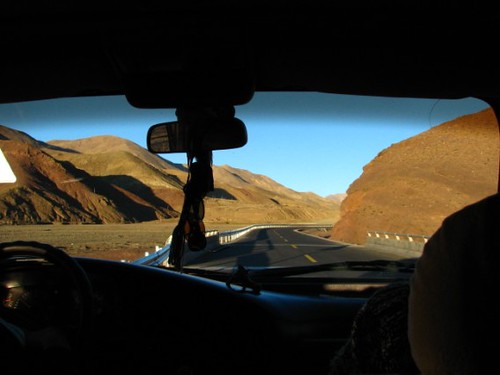 Leaving the plateau - in a jeep!
Leaving the plateau - in a jeep!
That being said, our immediate concern was to find a way out of the TAR. A fortuitous encounter with a very friendly and honest private travel agent in a restaurant was the opening we were after. He was half Nepali, half Tibetan and spoke fantastic English. In a revealing moment of conversation with him i remember him saying how he sometimes wished he was Superman so he could get rid of the Chinese from Tibet. He sorted us with a jeep all the way to the Nepali border for a very reasonable price. Nepal bound on the friendship HWY!! In a very flash, shiny jeep no less - with loads of leg room even!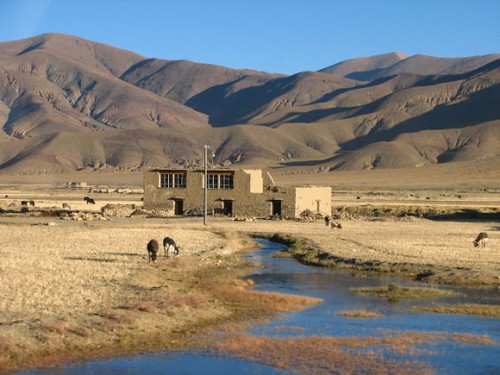 Rural house near Shigatse
Rural house near Shigatse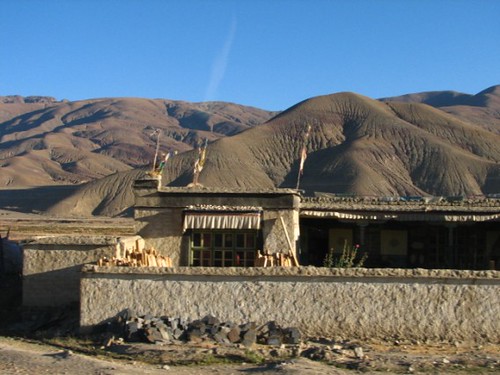 Rural house along the friendship highway
Rural house along the friendship highway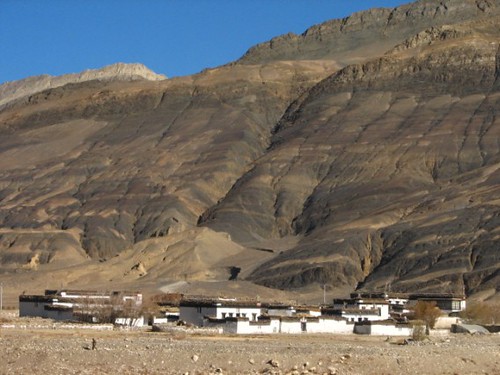 Village and stark mountains on the edge of Tibet
Village and stark mountains on the edge of Tibet
There was a Tibetan guide and a Chinese businessman also making the journey with us. We were determined to pick up a hitcher if we saw one, as there was enough room for at least one person to squeeze in the back! We actually came across a young Chinese backbacker headed for Nepal and managed to get him in between the packs.
The landscape changes after we crossed the final pass and entered the drainage basin into Nepal were amazing. Soooo fascinating from an environmental, climatic, ecological and landscape-evolution perspective.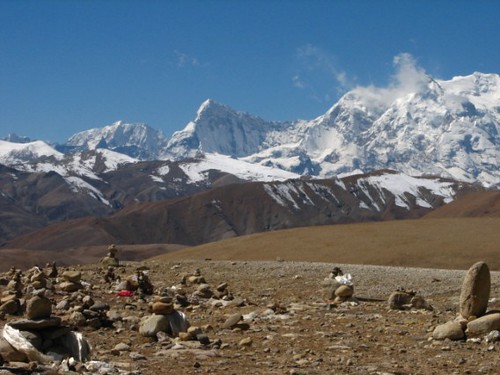 Mt Shishapangma from the pass that marks the start of the drainage catchment into Nepal. Bye to the TAR,.....
Mt Shishapangma from the pass that marks the start of the drainage catchment into Nepal. Bye to the TAR,.....
The down-cutting of the Bhote Kosi gorge into the main Himalaya range was sharp and rapid. Within the space of maybe 20 km, the bare, brown mountains of Tibet with their spattering of sparse, low-growing shrubs and dry grass, gave way to abundant towering conifers, luxuriantly damp rhododendron forests, bamboo groves and a fantasic array of other lush vegetation. Complete with moist, earthy-smells and waterfalls tumbling down impossibly gigantic cliffs, thundering sounds of rushing waters far below.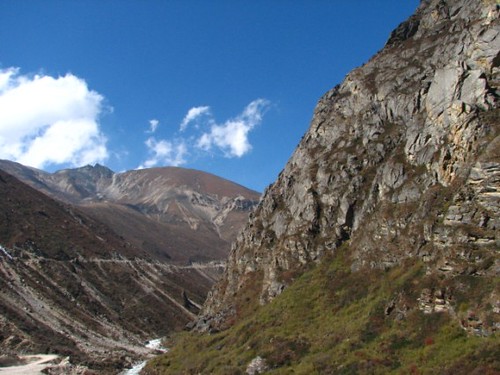 The beginning of the Bhote Kosi gorge into Nepal. In ~20 km it went from a dry and barren landscape to,.....
The beginning of the Bhote Kosi gorge into Nepal. In ~20 km it went from a dry and barren landscape to,.....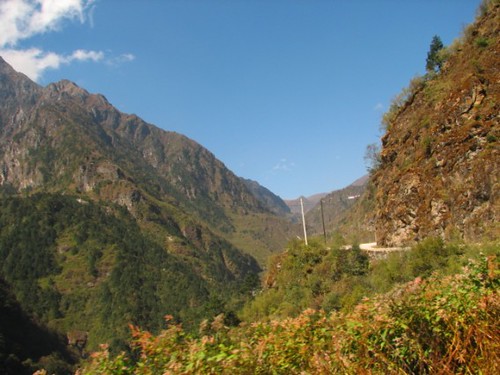 ,....to this. Lush pine forests, tumbling waterfalls and the sweet earthy smells of abundant vegetation
,....to this. Lush pine forests, tumbling waterfalls and the sweet earthy smells of abundant vegetation
Chinese immigration was too easy. I refrained from leaving a present with a flag and we wandered down to cross the border on the'Friendship bridge' over the Bhote Kosi - aromas of Dhal Bhat wafting up on the breeze. Then bang! - back into the frenzy and people-soup that is the mark of life on the sub-continent. The lushness and rainfall that lies on the southern side of the Himalaya makes a high population density possible - much unlike Tibet - but with that high density comes a grind against resource limitations, subsequent broad-scale poverty and increased disease, as warmth loving microbe populations also explode.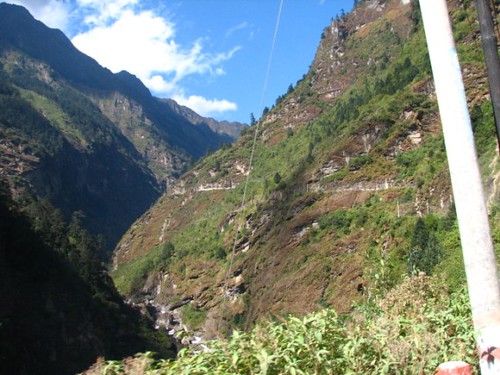 The Bhote Kosi gorge
The Bhote Kosi gorge
However, we were definitely more than thrilled to be back in Nepal and to have said goodbye to the coldness of human relations in the TAR. We quickly discovered we had walked straight back into a local Bandha (a transport strike) and getting to Kathmandu that afternoon would be impossible. So we chilled out, chatted with locals and ate instead.
The next 24 hrs was a hilarious example of sub-continent mayhem and disorganised chaos! There was also a bandha the next morning, only this one had been issued for the Kathmandu area and there would be no public transport available the whole day. After a few hours we discovered that this bandha did not apply to tourists, and there were various jeeps, taxis etc willing to take westerners to the capital. Teaming up with 4 young Belgians fresh in from the TAR we managed to sort a mini-bus direct to Kathmandu for an appropriate fee. No worries.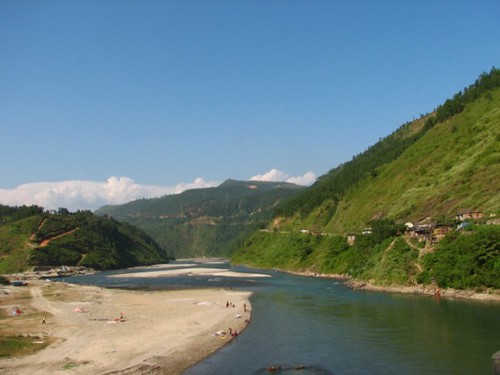 Bhote Kosi river
Bhote Kosi river
About a third of the way to Kathmandu we came across a massive road block - a truck parked diagonally across the road with ~100+ other trucks, buses and assorted vehicles tangled in a big jam behind it. Apparently this was a local issue where the truck drivers were sick of being held up and forced to pay 'road taxes' - by whom it was not clear - either Maoists, corrupt border police or rouge village louts out for some drinking money?? They were fed up (fair enough) and decided to protest by blocking the road to the border. Their plan was simple and cunning - hold up a whole bunch of westerners on the way to / from the border and force them to stay the night. The ensuing ruckus would attract lots of media and draw attention to their plight, which is certainly a bummer.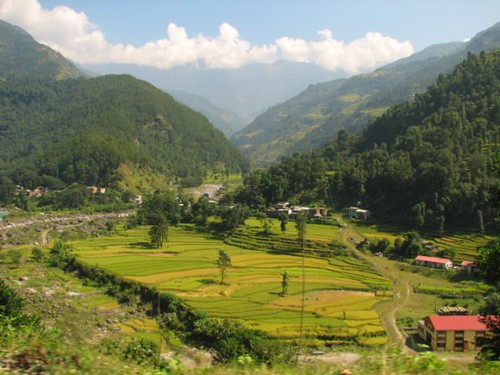 Lush field and rice paddies - back in the world of green things
Lush field and rice paddies - back in the world of green things
The Nepali drivers, in good old sub-continent fashion, resigned to this turn of events and sat down in groups playing cards or pulled up blankets and went to sleep under the shade of their vehicles. Several hundred westerners with plans, schedules, visas, group itineries and holidays to have, were not impressed and started crossing sides of the road block on foot, conversing with each other and the drivers who were not sleeping or playing cards, and thus began swapping transport. Once the process was underway, in the space of an hour most westerners had crossed the block and off on their way again. So much for the cunning plan!
We were shouldering our packs and about to do the same when an Ambulance came roaring up to the block from our side. Siren howling and a young woman inside with a post-op hemmorage - bound for Kathmandu. Our driver (not sleeping or card playing) saw the opportunity to retain his fee paying passengers and in 20 seconds we and our packs were jummbled back in the mini-bus and raced up behind the Ambulance. Like the red-sea, the blocking truck slowing parted. The Ambulance darted through the gap and so did we along with one other vehicle - before the gap closed again behind us. Ahead, a tangled maze of trucks and buses that we somehow managed to squeeze through - just - trying not to lose sight of the slightly narrower Ambulance.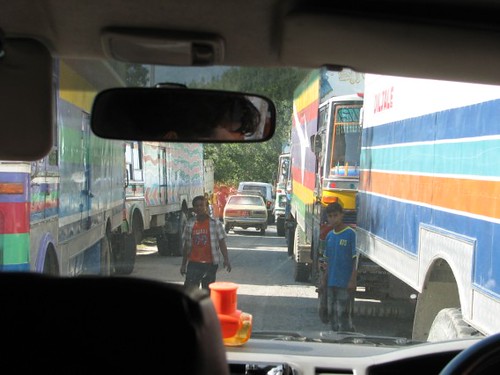 Following the ambulance through the truck road block
Following the ambulance through the truck road block
Several hundred meters later we emerged on the other side to a clear road, but the Ambulance was out of sight. Our driver sped off like a screaming banshee for the next several km of pin-twisting corners until he caught up with the Ambulance - at another massive road block! All the westerners who had creatively swapped sides to go on to Kathmandu were now well and truly trapped at another large block in a small town by a bridge over the Bhote Kosi. Going nowhere slowly.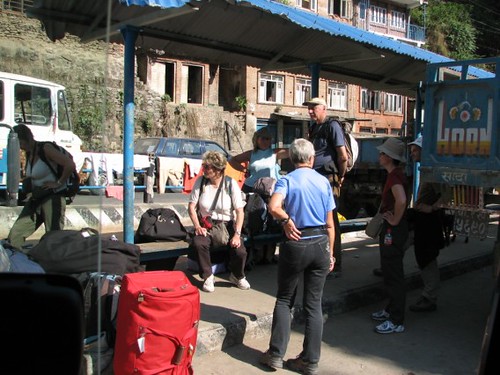 Restless injies stuck at the second block near the border
Restless injies stuck at the second block near the border
Again the Ambulance siren parted the sea of trucks and we followed in its wake. Our driver managed to deflect many questions he recieved from Nepali road-blockers about his dubious actions and equally dubious cargo. Apparently the woman in the back of the Ambulance was his mothers-brothers-sons-wifes-sister; so he was actually related and being a relative confers a legitimate right to tailgate them all the way to hostpital! The sea of trucks once again closed behind us, leaving many open-mouthed westerners staring at us in disbelief. Hot on the heels of the Ambulance, riding on someone elses misfortune, we raced along a traffic-free road to Kathmandu.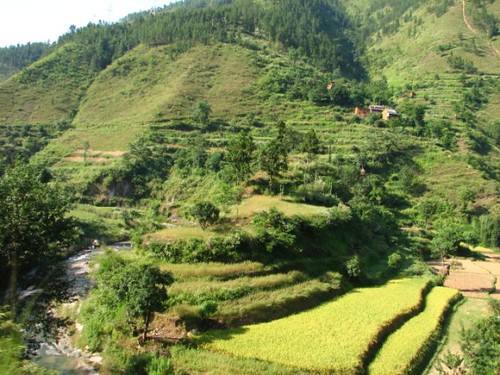 Lush fields in Nepal
Lush fields in Nepal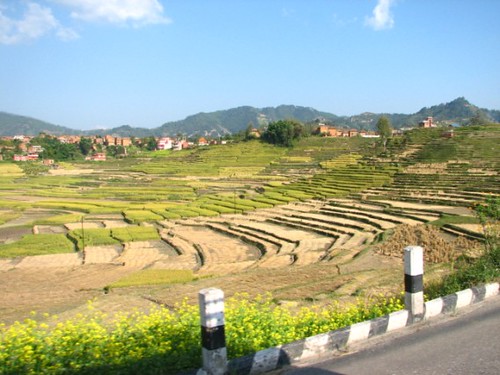 Terraces on the edge of Kathmandu
Terraces on the edge of Kathmandu
So ended this little journey, with classic pythonesque type sub-continent chaos. While it is true that most things this side of the Himalaya in Nepal are totally confused and chaotic with collapsing and delapidated infrastructure, there is a warmth in the people here that is genuine and unmistakable. The capitalist type efficiency and construction mania of the Chinese in the TAR was impressive, but the attitude and human relations ruthless and cold - i know which i prefer.
It was during the first day of staying in Boudha that i realised i had not heard the sound of kids playing the entire time i was in the TAR. In nepal they roam around in little packs making an endless ruckus of laughter and noise. I hadn't realised that this sound of normal life was missing - or at least rare in the TAR. I spoke to Mark about it and he commented that he once heard a group of kids playing and laughing in Lhasa and it shocked him - because he also realised at that point that he hadn't heard that sound since being in the TAR.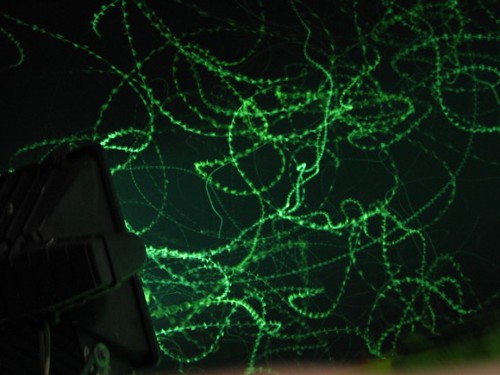 Flight trails of moths drawn to the light of the Boudha stupa
Flight trails of moths drawn to the light of the Boudha stupa
Anyway, if you managed to get through all of this, them i am dead impressed! I hope you got a laugh or two and enjoyed the pictures and journeying tales. Little flickers and fleeting impressions crossing the sky of the mind for but a moment, and then gone,.....
This concludes this travel blog, as it was established for the purpose of this journey and is now complete. Thanks for travelling with us! Much love and hugs from Anna and i.
ciao
Scott and Anna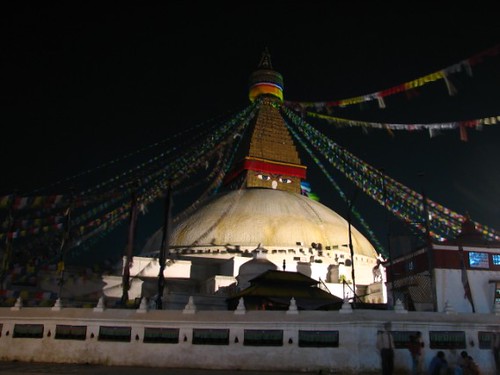 Boudhanath Stupa at night
Boudhanath Stupa at night
One wedding, several Koras and a very long way,......continued
Skip to Part 1
Skip to Part 2
Skip to Part 3



0 Comments:
Post a Comment
<< Home